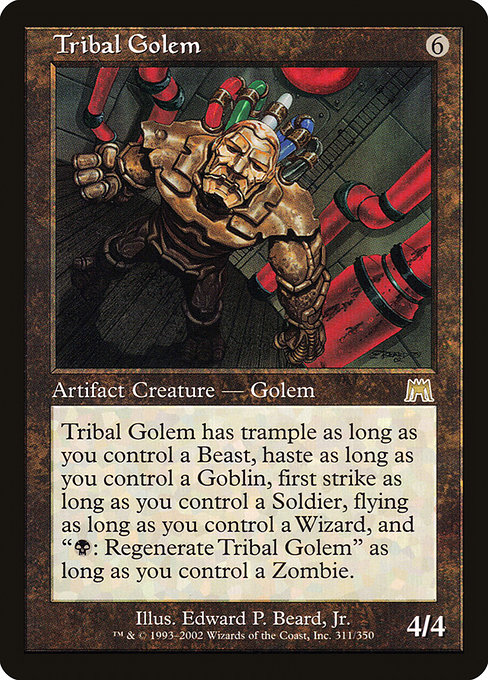
Image courtesy of Scryfall.com
Clustering MTG Cards by Mechanical Similarity
In the sprawling universe of Magic: The Gathering, cards often share more than a name or a creature type—they share a set of design DNA threads that tie them into families of mechanics. When you start grouping cards by how (and why) they interact with other pieces on the battlefield, you unlock a way to foresee synergies, anticipate weaknesses, and build decks with a coherent strategy rather than a grab bag of flashy effects. A perfect mirror for this approach is the rare artifact creature known as Tribal Golem from Onslaught. This six-mana behemoth doesn’t just sit as a 4/4 body; it acts like a mechanical Swiss Army knife, muttering a chorus of conditional abilities that hinge on the other creatures you control. 🧙♂️🔥
Tribal Golem is a colorless artifact creature with a black-flavored twist in its color identity (B). Its printed mana cost is {6}, and it breaks the typical one-ability-per-card mold by presenting a suite of micro-tribal interactions: it gains trample if you control a Beast, haste if you control a Goblin, first strike if you control a Soldier, flying if you control a Wizard, and regeneration for {B} as long as you control a Zombie. That means your deck’s creature portfolio—Beasts, Goblins, Soldiers, Wizards, Zombies—directly reshapes how this Golem behaves every turn. The effect is not just a gimmick; it’s a deliberate design to reward you for building a linked ecosystem on the battlefield. ⚔️💎
“This creature has trample as long as you control a Beast, haste as long as you control a Goblin, first strike as long as you control a Soldier, flying as long as you control a Wizard, and “{B}: Regenerate this creature” as long as you control a Zombie.”
Rarity and pedigree matter here as well. Tribal Golem appears in the Onslaught set (ons), released in 2002, a time when Wizards of the Coast leaned into tribal subthemes and the tactile thrill of artifact creatures in new, sometimes quirky, configurations. The card is a rare with a foil-print that can fetch a few dollars at market, while non-foil copies sit at a more accessible baseline. The art by Edward P. Beard, Jr. captures the gleaming, patchwork personality of a golem trying on every possible role—like a shapeshifter in a factory setting—organized chaos you can feel in every blocky line. 🎨
What this tells us about mechanical clustering
When we talk about clustering MTG cards by mechanics, Tribal Golem becomes a case study in cross-domain synergy. It sits at the intersection of multiple micro-traits rather than being a single, standalone keyword engine. Its trample-conditional on Beast presence, its haste-conditional on Goblins, and so forth, create a lattice of “if-then” relationships that line up with other cards in a deck. If you’re classifying by mechanical similarity, you might group Tribal Golem with other multi-tribal enablers from artifact-heavy or color-identity-forward designs, or you might place it in the subcategory of “conditional-buff artifacts”—cards that unlock different capabilities depending on your laboratory of creatures. The effect is not merely thematic; it’s a design-spawned blueprint for synergy that rewards players for maintaining a balanced, interwoven creature suite. 🧭
From a gameplay perspective, the Golem challenges you to think in terms of thresholds rather than raw mana efficiency. Why settle for a flat 4/4 on a 6-mana investment when you can push it into a suite of behaviors that scales with what you already control? That’s a delicious paradox that energizes deck-building conversations: do you aim to maximize one of the creature-type triggers, or do you cultivate a universal board presence that can flip any of the conditional triggers into real threats? The answer often depends on your meta, your color identity, and, frankly, your willingness to embrace a little chaos in the name of tribal camaraderie. 🧙♂️🔥
Practical takeaways for deck design and collection strategy
- Identify clusters not by single keywords but by the conditional web they weave. Tribal Golem is a prime example of how a single card can reward you for tailored board development rather than generic resource acceleration.
- Use color identity as a lens. Although it’s a colorless artifact, Tribal Golem’s binary association with black (for regeneration) invites you to consider how color-based resilience interacts with artifact engines in your own lists. ⚔️
- Appreciate the art of rarity and print history. As a rare from Onslaught with foil options, Tribal Golem also shows up in the valuation conversation that often drives collectors toward “biography cards” within tribal blocks. The foil’s willingness to hold top-dollar for nostalgia and playability makes it a nice benchmark for what “mechanical family portraits” can fetch in a collection. 💎
- Think across eras. Onslaught-era cards like Tribal Golem help illustrate how mechanical design from older sets still informs contemporary clustering exercises—especially when you compare them to modern cross-theme cards that also invite mixed-tribal play. 🎲
While the overarching topic of clustering can feel academic, these practical threads show how a single card can illuminate a broader design philosophy. It’s a reminder that MTG’s long history is a living lab for how mechanics intertwine, how tribes overlap, and how players curate their own mini ecosystems on the battlefield. And yes, it’s also a reminder that sometimes the most elegant path to victory is the path that lets your Golem borrow wings from Wizards and claws from Goblins—all while you sip coffee and plan your next game night. 🎨🧙♂️
While you mull over your next play, consider adding a modern-safe, protective companion to your collection—the kind of item that keeps your phone as ready as your deck. Explore the handy, impact-resistant phone case with card holder, a sleek example of form meeting function for fans who juggle cards and devices in the same day. Stay sharp, stay stylish, and may your draw steps be kind. 🔥
More from our network
- https://blog.digital-vault.xyz/blog/post/spectral-cloaks-hidden-defensive-uses-explained/
- https://blog.digital-vault.xyz/blog/post/handling-negative-feedback-gracefully-a-practical-guide/
- https://crypto-acolytes.xyz/blog/post/how-bitcoin-etfs-shape-market-dynamics-and-investor-behavior/
- https://blog.digital-vault.xyz/blog/post/unraveling-mummy-why-mtg-art-becomes-iconic/
- https://blog.digital-vault.xyz/blog/post/patient-rebuilding-investment-returns-across-mtg-eras/